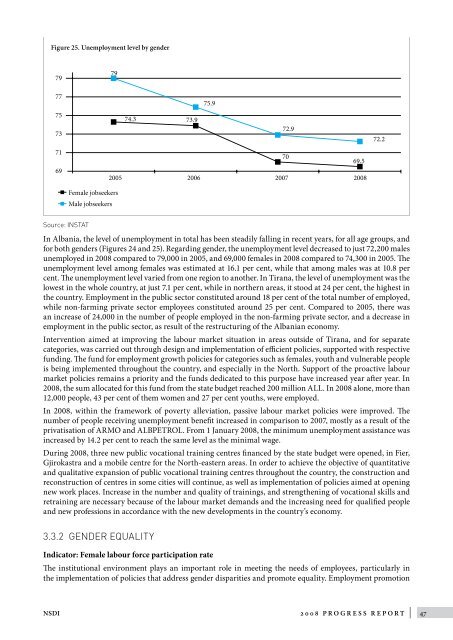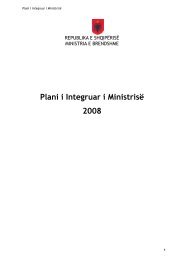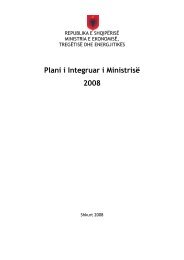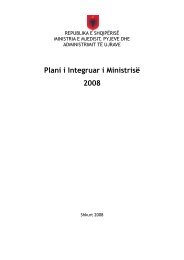Department of Strategy and Donor Coordination
Department of Strategy and Donor Coordination
Department of Strategy and Donor Coordination
Create successful ePaper yourself
Turn your PDF publications into a flip-book with our unique Google optimized e-Paper software.
Figure 25. Unemployment level by gender<br />
79<br />
79<br />
77<br />
75<br />
73<br />
71<br />
69<br />
75.9<br />
74.3<br />
73.9<br />
72.9<br />
70<br />
69.5<br />
2005 2006 2007 2008<br />
Female jobseekers<br />
Male jobseekers<br />
72.2<br />
Source: INSTAT<br />
In Albania, the level <strong>of</strong> unemployment in total has been steadily falling in recent years, for all age groups, <strong>and</strong><br />
for both genders (Figures 24 <strong>and</strong> 25). Regarding gender, the unemployment level decreased to just 72,200 males<br />
unemployed in 2008 compared to 79,000 in 2005, <strong>and</strong> 69,000 females in 2008 compared to 74,300 in 2005. The<br />
unemployment level among females was estimated at 16.1 per cent, while that among males was at 10.8 per<br />
cent. The unemployment level varied from one region to another. In Tirana, the level <strong>of</strong> unemployment was the<br />
lowest in the whole country, at just 7.1 per cent, while in northern areas, it stood at 24 per cent, the highest in<br />
the country. Employment in the public sector constituted around 18 per cent <strong>of</strong> the total number <strong>of</strong> employed,<br />
while non-farming private sector employees constituted around 25 per cent. Compared to 2005, there was<br />
an increase <strong>of</strong> 24,000 in the number <strong>of</strong> people employed in the non-farming private sector, <strong>and</strong> a decrease in<br />
employment in the public sector, as result <strong>of</strong> the restructuring <strong>of</strong> the Albanian economy.<br />
Intervention aimed at improving the labour market situation in areas outside <strong>of</strong> Tirana, <strong>and</strong> for separate<br />
categories, was carried out through design <strong>and</strong> implementation <strong>of</strong> efficient policies, supported with respective<br />
funding. The fund for employment growth policies for categories such as females, youth <strong>and</strong> vulnerable people<br />
is being implemented throughout the country, <strong>and</strong> especially in the North. Support <strong>of</strong> the proactive labour<br />
market policies remains a priority <strong>and</strong> the funds dedicated to this purpose have increased year after year. In<br />
2008, the sum allocated for this fund from the state budget reached 200 million ALL. In 2008 alone, more than<br />
12,000 people, 43 per cent <strong>of</strong> them women <strong>and</strong> 27 per cent youths, were employed.<br />
In 2008, within the framework <strong>of</strong> poverty alleviation, passive labour market policies were improved. The<br />
number <strong>of</strong> people receiving unemployment benefit increased in comparison to 2007, mostly as a result <strong>of</strong> the<br />
privatisation <strong>of</strong> ARMO <strong>and</strong> ALBPETROL. From 1 January 2008, the minimum unemployment assistance was<br />
increased by 14.2 per cent to reach the same level as the minimal wage.<br />
During 2008, three new public vocational training centres financed by the state budget were opened, in Fier,<br />
Gjirokastra <strong>and</strong> a mobile centre for the North-eastern areas. In order to achieve the objective <strong>of</strong> quantitative<br />
<strong>and</strong> qualitative expansion <strong>of</strong> public vocational training centres throughout the country, the construction <strong>and</strong><br />
reconstruction <strong>of</strong> centres in some cities will continue, as well as implementation <strong>of</strong> policies aimed at opening<br />
new work places. Increase in the number <strong>and</strong> quality <strong>of</strong> trainings, <strong>and</strong> strengthening <strong>of</strong> vocational skills <strong>and</strong><br />
retraining are necessary because <strong>of</strong> the labour market dem<strong>and</strong>s <strong>and</strong> the increasing need for qualified people<br />
<strong>and</strong> new pr<strong>of</strong>essions in accordance with the new developments in the country’s economy.<br />
3.3.2 gender equality<br />
Indicator: Female labour force participation rate<br />
The institutional environment plays an important role in meeting the needs <strong>of</strong> employees, particularly in<br />
the implementation <strong>of</strong> policies that address gender disparities <strong>and</strong> promote equality. Employment promotion<br />
NSDI 2008 Progress Report | 47










